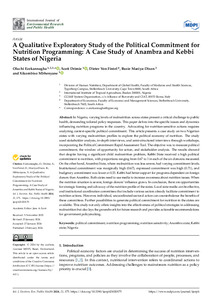| dc.contributor.author | Ezekannagha, O. |
| dc.contributor.author | Drimie, S. |
| dc.contributor.author | Von Fintel, D. |
| dc.contributor.author | Maziya-Dixon, B. |
| dc.contributor.author | Mbhenyane, X. |
| dc.date.accessioned | 2024-02-09T15:16:37Z |
| dc.date.available | 2024-02-09T15:16:37Z |
| dc.date.issued | 2024-02-24 |
| dc.identifier.citation | Ezekannagha, O., Drimie, S., Von Fintel, D., Maziya-Dixon, B. & Mbhenyane, X. (2024). A qualitative exploratory study of the political commitment for nutrition programming: a case study of Anambra and Kebbi States of Nigeria. International Journal of Environmental Research and Public Health, 21(2): 175, 1-16. |
| dc.identifier.issn | 1660-4601 |
| dc.identifier.uri | https://hdl.handle.net/20.500.12478/8395 |
| dc.description.abstract | In Nigeria, varying levels of malnutrition across states present a critical challenge to public health, demanding tailored policy responses. This paper delves into the specific issues and dynamics influencing nutrition programs in the country. Advocating for nutrition-sensitive actions requires analyzing context-specific political commitment. This article presents a case study on two Nigerian states with varying malnutrition profiles to explore the political economy of nutrition. The study used stakeholder analysis, in-depth interviews, and semi-structured interviews through workshops, incorporating the Political Commitment Rapid Assessment Tool. The objective was to measure political commitment, the window of opportunity for action, and stakeholder analysis. The results showed that despite having a significant child malnutrition problem, Kebbi State received a high political commitment to nutrition, with proportions ranging from 0.67 to 1 in each of the six domains measured. On the other hand, Anambra State, where malnutrition was less severe, had varying commitment levels. Institutional commitment was marginally high (0.67), expressed commitment was high (0.71), and budgetary commitment was lower at 0.33. Kebbi had better support for programs dependent on foreign donors than Anambra. Both states need to use media to increase awareness about nutrition issues. When the nutrition situation is severe, foreign donors’ influence grows. In conclusion, there are opportunities for strategic framing and advocacy of the nutrition profile of the states. Local state media can be effective, and institutional coordination committees that include various sectors already facilitate commitment to nutrition actions. However, individual, uncoordinated sectoral action can counterbalance the benefits of these committees. Further possibilities to generate political commitment for nutrition in the states are available. This study not only offers insights into the effectiveness of political strategies in addressing malnutrition but also lays the groundwork for future research and provides actionable recommendations for government policymaking. |
| dc.description.sponsorship | National Research Foundation—Third World Academy of Science |
| dc.description.sponsorship | Margret McNamara Education Grant |
| dc.description.sponsorship | International Institute of Tropical Agriculture |
| dc.description.sponsorship | Harry Crossley Fund |
| dc.format.extent | 1-16 |
| dc.language.iso | en |
| dc.subject | Nutrition |
| dc.subject | Public Health |
| dc.subject | Livelihoods |
| dc.subject | Nigeria |
| dc.title | A qualitative exploratory study of the political commitment for nutrition programming: a case study of Anambra and Kebbi States of Nigeria |
| dc.type | Journal Article |
| cg.contributor.crp | Maize |
| cg.contributor.crp | Roots, Tubers and Bananas |
| cg.contributor.affiliation | Stellenbosch University |
| cg.contributor.affiliation | International Institute of Tropical Agriculture |
| cg.coverage.region | Africa |
| cg.coverage.region | West Africa |
| cg.coverage.country | Nigeria |
| cg.coverage.hub | Headquarters and Western Africa Hub |
| cg.researchtheme | Nutrition and Human Health |
| cg.isijournal | ISI Journal |
| cg.authorship.types | CGIAR and developing country institute |
| cg.iitasubject | Food Security |
| cg.iitasubject | Food Systems |
| cg.iitasubject | Livelihoods |
| cg.iitasubject | Nutrition |
| cg.journal | International Journal of Environmental Research and Public Health |
| cg.notes | Open Access Article |
| cg.accessibilitystatus | Open Access |
| cg.reviewstatus | Peer Review |
| cg.usagerightslicense | Creative Commons Attribution 4.0 (CC BY 0.0) |
| cg.targetaudience | Scientists |
| cg.identifier.doi | https://doi.org/10.3390/ijerph21020175 |
| cg.iitaauthor.identifier | Busie Maziya-Dixon: 0000-0003-2014-2201 |
| cg.futureupdate.required | No |
| cg.identifier.issue | 2: 175 |
| cg.identifier.volume | 21 |

